#woody nightshade
Text

old Magic
#Canine#Dog#Coyote#Wolf#Full moon#New moon#Gold#Gilded#Tansy#Agrimony#Burdock#Bittersweet nightshade#Woody nightshade#Pinwheel mushroom#Fungus#Fungi#Hag stone#Mourning dove feather#Water#Bones#Witch#Spiritual#Herbalism#Herbs#Weeds#Protection#Spells#Folk magic#Medicinal#Defense
38 notes
·
View notes
Text

October 2023
#cottagecore#dark cottagecore#forestcore#rangercore#naturecore#plants#bittersweet#woody nightshade#nature photography#autumn
1 note
·
View note
Video
n69_w1150 by Biodiversity Heritage Library
Via Flickr:
The instructive picture book, or, Lessons from the vegetable world Edinburgh :Edmonston & Douglas, 87 Princes Street,1858. biodiversitylibrary.org/page/59644192
#Fruit#Juvenile literature#Pictorial works#Plants#Vegetables#Lloyd Library and Museum#bhl:page=59644192#dc:identifier=https://biodiversitylibrary.org/page/59644192#taxonomy:common=Monk’s-hood#taxonomy:common=Woody nightshade#taxonomy:binomial=Aconitum napellus#taxonomy:binomial=Solanum dulcamara#flickr#monk's-hood#woody nightshade#aconitum napellus#solanum dulcamara#Aconite#monkshood#Venus' chariot#wolfsbane#bittersweet#bittersweet nightshade#bitty nightshade#blue bindweed#Amara Dulcis#climbing nightshade#felonwort#fellenwort#felonwood
1 note
·
View note
Text
English Folk/Traditional Names for Common Plants & Herbs

These are known now as folk names, but back in the medieval era and well into the 18th century, these were the common names for some of the herbs and plants in use in witchcraft (and generally!) today.
This list is not an exhaustive one; the names given here are just some of the names that were used primarily in England for common plants within the region.These plants have other unique and wonderful names in many other cultures and languages throughout the world.
✧ ADDER’S TONGUE (Ophioglossum Vulgatum)
A.K.A.: English Adder’s Tongue, Snake’s Tongue, Viper’s Tongue, Serpent’s Tongue, Adder’s Spear, Christ’s Spear.
✧ AGRIMONY (Agrimonia Eupatoria)
A.K.A.: Harvest Lice, Cat’s Tail, Liverwort, Sticklewort, Stickwort, Stickweed, Fairy’s Wand, Church Steeples, Aaron’s Rod, Beggar’s Lice/Ticks.
✧ ALDER (Alnus Glutinosa)
A.K.A.: Black Alder, Fever Bush, Owler.
✧ ANGELICA (Angelica Archangelica)
A.K.A.: Holy Ghost/Root of the Holy Ghost, St. Michael’s flower, Angel’s Food.
✧ ANISE (Pimpinella Anisum)
A.K.A.: Sweet Alice, Aniseed.
✧ APPLE (Malus)
A.K.A.: Fruit of the Gods, Fruit of the Underworld, Silver Branch, Silver Bough.
✧ ASH (Fraxinus Excelsior)
A.K.A.: Bird’s Tongue, Hampshire Weed, Widow-maker, Venus of the Woods, Husbandman’s tree.
✧ BALSAM (Commiphora Opolbalsamum)
A.K.A.: Balsam of Gilead, Balm Tree, Mecca Myrrh.
✧ BASIL (Oscimum Basilicum)
A.K.A.: Our Herb, St. Joseph’s Wort, Witches’ Herb, King of Herbs, Holy Basil.
✧ BAY (Laurus Nobilis)
A.K.A.: Bay Laurel, True Laurel, Daphne, Noble Laurel.
✧ BERGAMOT (Monarda Didyma)
A.K.A.: Horsebalm, Bee Balm, Scarlet Mondara.
✧ BIRCH (Betula Pendula)
A.K.A.: Silver Birch, White Birch, Lady of the Woods.
✧ BITTERSWEET (Solanum Dulcamara)
A.K.A.: Woody Nightshade, Felon-wort, Felonwood, Blue Nightshade, Fever Twig, Staff Vine, Violet Bloom.
✧ BLACKBERRY (Rubus Fruticosus)
A.K.A.: Bramble, Fingerberry, Blackhide, Blackbutter, Thimbleberrym Brambleberry, Gouthead.
✧ BLUEBELL (Hyacinthoides Non Scrupta)
A.K.A.: Nodding Squill, Auld Man’s Bell, Ring-o-bells, Wood Bells.
✧ BROOM (Cytisus Scoparius)
A.K.A.: Besom, Irish Tops, Scotch Broom, Butcher’s Broom, Sweet Broom.
✧ BURDOCK (Arctium Lappa)
A.K.A.: Thorny Burr, Beggar’s Buttons, Sticky Bobs, Love Leaves, Hare Burr.
✧ CARNATION (Dianthus Caryophyllus)
A.K.A.: Gilliflower, July Flower, Clove Pink, Sops-in-wine.
✧ CHAMOMILE (Anthemis Nobilis)
A.K.A.: Whig Plant, Chamomel, Earth/Ground Apple,
✧ CHESTNUT [SWEET] (Castanea Sativa)
A.K.A.: Marion, Jupiter’s Nut.
✧ CHICKWEED (Stellaria Media)
A.K.A.: Starweed, Adder’s Mouth, Scarweed/wort, Tongue Grass, Stitchwort, White Bird’s Eye, Little Star Lady.
✧ CHICORY (Cichorium Intybus)
A.K.A.: Witloof, Blue Sailors, Coffeeweed.
✧ CLARY [WILD] (Salvia Verbenaca)
A.K.A.: Christ’s Eye, Wild Clear-eye, Vervain Sage, Eyeseed.
✧ CLEAVERS (Galium Aparine)
A.K.A.: Catchweed, Beggar Lice, Goose Grass, Sticky Willy, Bedstraw, Robin-run-the-hedge, Goose’s Hair, Hedge-burrs, Milk Sweet, Stick-a-back, Scratchweed, Barweed.
✧ COMFREY (Symphytum Officinale)
A.K.A.: Knitbone, Slippery Root, Blackwort, Bruisewort, Ass Ear.
✧ DAISY (Bellis Perennis)
A.K.A.: Day’s Eye, Poet’s Darling, Bachelor’s Buttons, Bairnwort, Billy Buttons, Boneflower, Margaret’s Herb.
✧ DANDELION (Taraxacum Officinale)
A.K.A.: Swine’s Snout, Blowball, Puffball, Clockflower, Tell-the-time, Priest’s Crown, Lion’s Tooth.
✧ DEADLY NIGHTSHADE (Atropa Belladonna)
A.K.A.: Belladonna, Banewort, Black-cherry, Devil’s Cherries, Naughty Man’s Cherries, Devil’s Herb.
✧ FEVERFEW (Tanacetum Parthenium)
A.K.A.: Featherfew, Featherfoil, Midsummer Daisy, Nosebleed.
✧ FOXGLOVE (Digitalis Purpurea)
A.K.A.: Fairy Gloves/Fingers/Petticoats/Thimbles/Weed, Witches’ Glove, Witches’ Bells, Our Lady’s Glove, Dead Men’s Bells.
✧ GARLIC (Allium Sativum)
A.K.A.: Poor Man’s Treacle, Stinkweed, Camphor of the Gods.
✧ GOLDENROD (Solidago Vibgaurea)
A.K.A.: Aaron’s Rod, Cast the Spear.
✧ HAWTHORN (Crataegus Monogyna)
A.K.A.: May Blossom, Mayflower, Whitethorn, Hagthorn, Ladies’ Meat.
✧ HELLEBORE [BLACK] (Helleborus Niger)
A.K.A.: Bear’s Foot, Setter-wort/grass.
✧ HEMLOCK (Conium Maculatum)
A.K.A.: Poison Hemlock, Devil’s Porridge.
✧ HENBANE (Hysoscyamus Niger)
A.K.A.: Hog Bean, Stinking Nightshade, Henbell, Devil’s Eye, Witches’ Herb, Devil’s Tobacco.
✧ HOLLY (Ibex Auifolium)
A.K.A.: Bat’s Wings, Holy Tree, Christ’s Thorn.
✧ HONEYSUCKLE (Lonicera Periclymenum)
A.K.A.: Woodbind, Fairy Trumpets, Sweet Suckle, Honeybind.
✧ HOREHOUND [BLACK] (Ballota Nigra)
A.K.A.: Madwort, Black Hoarhound, Black Archangel.
✧ HOREHOUND [WHITE] (Marrubium Vulgare)
A.K.A.: Bull’s Blood, White Archangel, Eye of the Star, Houndbane, Devil’s Eye.
✧ IVY (Hedera Helix)
A.K.A.: Gort, Bindwood, Lovestone.
✧ JUNIPER (Juniperus Communis)
A.K.A.: Bastard Killer, Gin Berry.
✧ LADY’S MANTLE (Alchemilla Vulgaris)
A.K.A.: Our Lady’s Mantle, Lion’s Foot, Bear’s Foot, Nine Hooks.
✧ LAVENDER (Lavendula Angustifolia)
A.K.A.: Elf Leaf, Spikenard, True Lavender.
✧ LEMON BALM (Melissa Officinalis)
A.K.A.: Sweet Melissa, Bee Balm, Sweet Balm.
✧ LEMON VERBENA (Aloysia Triphylla)
A.K.A.: Lemon Louisa, Lemon Beebrush.
✧ LILY OF THE VALLEY (Convallaria Majalis)
A.K.A.: May Lily, Our Lady’s Tears, Mary’s Tears, Ladder to Heaven.
✧ MALLOW (Malva Sylvestris)
A.K.A.: Cheese-cake, Pick-cheese, Round Dock, Wild Mallow, Wood Mallow.
✧ MANDRAKE (Mandragora Officinarum)
A.K.A.: Satan’s Apple, Love Plant, Mandragora.
✧ MARIGOLD (Calendula Officinalis)
A.K.A.: Bride of the Sun, Drunkard, Husbandman’s Dial, Mary Gold, Summer’s Bride.
✧ MARJORAM (Origanum Majorana)
A.K.A.: Wintersweet, Joy of the Mountain, Mountain Mint.
✧ MEADOWSWEET (Filipendula Ulmaria)
A.K.A.: Bridewort, Queen of the Meadows, Little Queen, Quaker Lady, Mead Sweet, Gravel Root.
✧ MINT [PEPPERMINT] (Mentha Piperita)
A.K.A.: Brandy Mint, English Mint.
✧ MINT [SPEARMINT] (Mentha Spicata)
A.K.A.: Garden Mint, Hart Mint, Our Lady’s Mint, Sage of Bethlehem.
✧ MISTLETOE (Viscum Coloratum)
A.K.A.: Druid’s Herb, Witches’ Broom, Wood of the Cross, Golden Bough, Devil’s Fuge.
✧ MONKSHOOD (Aconitum Napellus)
A.K.A.: Monk’s Blood, Blue Wolf’s-bane, Aconite, Women’s Bane, Devil’s Helmet, Friar’s Cap.
✧ MUGWORT (Artemisia Vulgaris)
A.K.A.: Lion’s Tail, Lion’s Tart, Heart-wort.
✧ MULLEIN (Verbascum Thapsus)
A.K.A.: Blanket/Velvet/Woolly Mullein, Our Lady’s Blanket, Beggar’s Blanket, Aaron’s Rod, Adam’s Rod, Jupiter’s Staff, Jacob’s Staff, Peter’s Staff, Virgin Mary’s Candle, Lady’s Foxglove, Graveyard Dust.
✧ NETTLE (Urtica Dioica)
A.K.A.: Stinging Nettle, Burn Weed, Burn Hazel.
✧ PARLSEY (Petroselinum Crispum)
A.K.A.: Devil’s Oatmeal, Persil.
✧ PENNYROYAL (Mentha Legium)
A.K.A.: Royal Thyme, Run-by-the-ground, Lurk-in-the-ditch, Pudding Grass.
✧ ROSEMARY (Rosemarinus Officinalis)
A.K.A.: Dew of the Sea, Sea Dew, Elf Leaf, Guardrobe, Rose of Mary.
✧ RUE (Ruta Graveolens)
A.K.A.: Herb of Grace, Herb of Repentance, Mother of Herbs.
✧ [CLARY] SAGE (Salvia Sclarea)
A.K.A.: Clear-Eye, See-bright, Eyebright.
✧ ST. JOHN’S WORT (Hypericum Perforatum)
A.K.A.: Scare-devil, Balm of the Warrior’s Wound, Rose of Sharon.
✧ SORREL (Rumex Acetose)
A.K.A.: Green Sauce, Sour Sauce, Cuckoo Sorrow.
✧ SWEET WOODRUFF (Galium Odoratum)
A.K.A.: Wild Baby’s Breath, Master of the Woods, Ladies in the Hay.
✧ TANSY (Tanacetum Vuulgare)
A.K.A.: Bitter Buttons, Golden Buttons, Cow Bitter.
✧ TARRAGON (Artemisia Dracunculus)
A.K.A.: Dragon’s Wort, Little Dragon.
✧ THISTLE [BLESSED] (Cnicus Benedictus)
A.K.A.: Holy Thistle.
✧ THISTLE [MILK] (Silybum Marianum)
A.K.A.: Our Lady’s Thistle, Saint Mary’s Thistle, Sow Thistle, Marian Thistle.
✧ VALERIAN (Valeriana Officinalis)
A.K.A.: Garden Heliotrope, St. George’s Herb, Bloody Butcher, Cat’s Valerian, Vandal Root.
✧ VERVAIN (Verbena Officinalis)
A.K.A.: Herb of Grace, Enchanter’s Herb, Britannica, Juno’s Tears, Divine Wood, Pigeongrass,
✧ WITCH HAZEL (Hamamelis Virginiana)
A.K.A.: Spotted Alder, Winterbloom, Snapping Hazelnut.
✧ WORMWOOD (Artemisia Absinthium)
A.K.A.: Absinthe, Crown for a King, Green Ginger.
✧ YARROW (Achillea Millefolium)
A.K.A.: Woundwort, Nose-Bleed, Thousand-Leaf, Arrowroot, Carpenter’s Weed, Devil’s Plaything, Devil’s Nettle,
Sources, References and Cross-Checks: Breverton's Complete Herbal (Terry Breverton), Encyclopedia of Magical Herbs (Scott Cunningham), Medieval Plant Names and Their Modern Corollaries (The Met Cloister).
If you like my content and would like to help me keep providing free stuff for my gorgeous Ghoul Gang, you can tip your witch here: [Paypal].
698 notes
·
View notes
Text
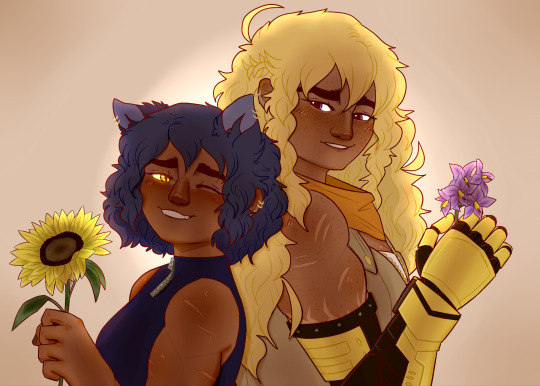
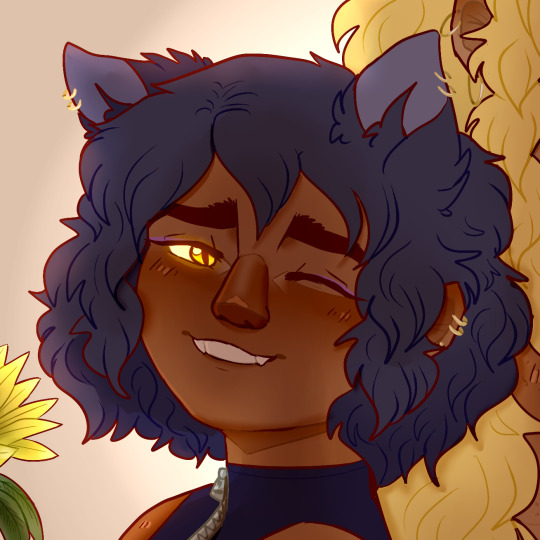
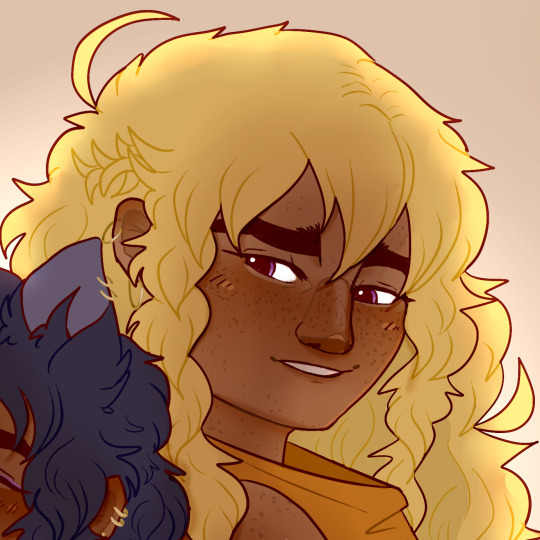
bumbleby right before valentine's day just feels right to me!!
sunflower + woody nightshade (a not as poisonous variety that's safe to touch bc i didn't wanna poison yang obviously)
178 notes
·
View notes
Note
you are so annoying wow
thanks! since im sure you want this posted for everyone to see how cool and poggers your epic burn was, ill take the opportunity to talk actually fun instead:
THE ANGEL'S TRUMPET!!!!
now you know me im a fellow marine biologist enthusiast so of course id like to talk about Magnapinna or Architeuthis but i also am a fan of good ole homeland-soil life as well. and this means were talking about a south american flower!
Brugmansia is a genus of 7 species in the nightshade (Solanaceae) family!!!! theyre woody trees/shrubs and carry pendular, large flowers (as opposed to datura's upright flowers).
the 7 species are divided between brugmansia (warm growing) and sphaerocarpium (cold growing), which i find really cool (cuz its new info to me!). the brugmansia group is the one im most familiar with: it consists of B. aurea, B. insignis, B. suaveolens, and B. versicolor. insignis and suaveolens are the ones found in brazil! ive seen a couple myself:

(these are pink B. suaveolens!)
the other group, sphaerocarpium, consists of B. arborea, B. sanguinea and B. vulcanicola. the latter two are pretty weird-looking, and B. vulcanicola was once thought to be a subspecies of B. sanguinea!


(here are B. sanguinea and B. vulcanicola, side by side)
NOW as for why these are my favorites: these babies are can cause hallucinations, and have been used traditionally by many native south american groups both for medicine and religious practices! i originally found this plant online, and the first time i saw it in real life it brought so much joy to me that it was hard to describe in words. as we do with plants, this one is available outside brazil in some places, so if you know of a garden or glasshouse that has it, make sure to go see it! theyre really big and cool to look at <3
39 notes
·
View notes
Text
Kohaku's Bouquet
This was a request from @moridesne on Twitter:
"Can you identify the flowers that Kohaku carries? I got interested in "flower language" (thanks to Gen) lately and I wonder if the flowers she's holding have hidden meaning or they were just merely meant to hide her weapon?"

So I don't think either flower is an exact species, but I do have some guesses along with why I don't think they're real. This is them as colored in the anime, you can see the white ones are small and dense and the red/orange ones are large. There seems to be 2 types of foliage judging by the two shades of green used. The red flowers I believe may be inspired by lilies, specifically a variety that has ruffled edges to match the original style. They're not perfect because the number of petals is wrong and Kohaku's don't seem to have any that are opened.
They're also very vertical, which could mean it's a flower similar to a tulip, however their petals don't get as long as the ones in the drawing.

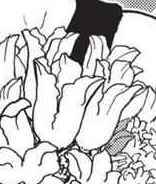

The white flowers I don't even have a guess for because of several of what I believe to be contradictory things. They're small white flowers with 5 petals and flat middles/no protruding pistils, the stems appear woody because of the jaggedness and the flowers aren't clustered.

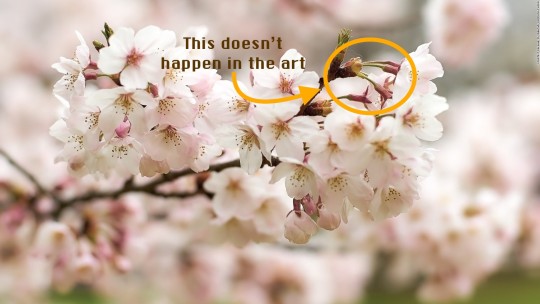

In the anime, the stems don't appear woody at all. The reason this makes things difficult is because it would help separate between a tree's flowers and a shrub's. As such, I can't tell if it's meant to be something like cherry blossoms or something like star of bethlehem.

The final problem is the middle of the flower. The first image is from the nightshade family, and it has the correct stalk and petals, but it has a protruding pistil. This is also Gen's flower, and we've seen that it's drawn with the pistil showing.


TL;DR: There's probably no deeper meaning, they just look pretty.
15 notes
·
View notes
Text
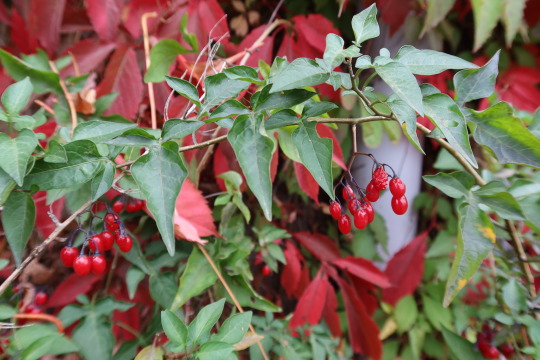
Solanum dulcamara — bittersweet a.k.a. bittersweet nightshade a.k.a. bitter nightshade a.k.a. blue bindweed a.k.a. climbing nightshade a.k.a. felonwort a.k.a. fellenwort a.k.a. poisonberry a.k.a. poisonflower a.k.a. scarlet berry a.k.a. snakeberry a.k.a. trailing bittersweet a.k.a. trailing nightshade, a.k.a. violet bloom a.k.a. woody nightshade
7 notes
·
View notes
Text
Warrior Cats Prefixes List- B
I had a WC Name Generator on Perchance that I made but I don't seem to have access anymore, so I'm remaking it here as just a simple list. The definitions used are the ones that Clan cats have for those things, and thus are the origins of the names. Definitions used are whatever I found when I googled it.
Badger-: "[noun] a heavily built omnivorous nocturnal mammal of the weasel family, typically having a gray and black coat"
Bark-: "[noun] an outer layer of a woody plant such as a tree or stick; [noun] the sharp explosive cry of certain animals, especially a dog, fox, or seal"
Barley-: "[noun] a hardy cereal that has coarse bristles extending from the ears"
Basalt-: "[noun] a dark, fine-grained volcanic rock that sometimes displays a columnar structure"
Basil-: "[noun] an aromatic annual herb of the mint family; [noun] the leaves of the basil plant"
Bass-: "[noun] any of numerous edible marine or freshwater bony fishes"
Bat-: "[noun] any of a widely distributed order of nocturnal flying mammals that have wings formed from four elongated digits of the forelimb covered by a cutaneous membrane and rely on echolocation"
Bay-: "[noun] a broad inlet of the sea where the land curves inward; [noun] an indentation or recess in a range of hills or mountains"
Beach-: "[noun] a strip of land covered with sand, pebbles, or small stones at the edge of a body of water"
Bear-: "[noun] a large, heavy mammal that walks on the soles of its feet, having thick fur and a very short tail"
Beaver-: "[noun] a large semiaquatic broad-tailed rodent that is native to North America and northern Eurasia"
Bee-: "[noun] a honeybee; [noun] an insect of a large group to which the honeybee belongs, including many solitary as well as social kinds"
Beech-: "[noun] a large tree with smooth gray bark, glossy leaves, and hard, pale, fine-grained timber"
Beetle-: "[noun] an insect of an order distinguished by forewings typically modified into hard wing cases that cover and protect the hind wings and abdomen"
Belladonna-: "[noun] another name for the deadly nightshade plant"
Bellflower-: "[noun] a plant with bell-shaped flowers that are usually blue, purple, pink, or white"
Berry-: "[noun] a small roundish juicy fruit without a stone"
Big-: "[adj] of considerable size, extent, or intensity"
Bilberry-: "[noun] a small dark blue edible berry; [noun] a hardy dwarf shrub closely related to the blueberry, with red drooping flowers and dark blue edible berries"
Birch-: "[noun] a slender, fast-growing tree that has thin bark (often peeling) and bears catkins"
Bird-: "[noun] a warm-blooded egg-laying vertebrate distinguished by the possession of feathers, wings, and a beak and (typically) by being able to fly"
Bison-: "[noun] a humpbacked shaggy-haired wild ox native to North America and Europe"
Bitter-: "[adj] having a sharp, pungent taste or smell; not sweet"
Black-: "[noun] black color or pigment; [adj] of the very darkest color owing to the absence of or complete absorption of light; the opposite of white"
Blackberry-: "[noun] an edible soft fruit consisting of a cluster of soft purple-black drupelets; [noun] the prickly climbing shrub of the rose family that bears blackberries"
Blackbird-: "[noun] a European thrush with mainly black plumage; [noun] an American bird with a strong pointed bill. The male has black plumage that is iridescent or has patches of red or yellow"
Blaze-: "[noun] a very large or fiercely burning fire; [verb] burn fiercely or brightly"
Blazing-: "[verb] burn fiercely or brightly"
Blight-: "[noun] a plant disease, typically one caused by fungi such as mildews, rusts, and smuts (smut as defined as a fungal disease of grains); [verb] infect (plants) with blight"
Blizzard-: "[noun] a severe snowstorm with high winds and low visibility"
Bloom-: "[noun] a flower, especially one cultivated for its beauty; [noun] a delicate powdery surface deposit on certain fresh fruits, leaves, or stems; [verb] to produce flowers, to be in flower"
Blossom-: "[noun] a flower or a mass of flowers, especially on a tree or bush; [verb] (of a tree or bush) produce flowers or masses of flowers"
Blue-: "[noun] blue color or pigment; [adj] of a color intermediate between green and violet, as of the sky or sea on a sunny day"
Bluebell-: "[noun] a European woodland plant of the lily family that produces clusters of blue bell-shaped flowers in spring; [noun] any of a number of other plants with blue bell-shaped flowers"
Blueberry-: "[noun] the small sweet blue-black edible berry of the blueberry plant; [noun] a hardy dwarf shrub of the heath family, with small, whitish drooping flowers and dark blue edible berries"
Bluebird-: "[noun] an American songbird of the thrush subfamily, the male of which has a blue head, back, and wings"
Boa-: "[noun] a constrictor snake which bears live young and may reach great size, native to America, Africa, Asia, and some Pacific islands"
Boar-: "[noun] a tusked Eurasian wild pig from which domestic pigs are descended; [noun] a male domestic pig"
Bog-: "[noun] wet muddy ground too soft to support a heavy body"
Bolt-: "[verb] (of an animal) run away suddenly out of control; [noun] thunderbolt"
Bone-: "[noun] any of the pieces of hard whitish tissue making up the skeleton in vertebrates; [noun] the calcified material of which bones consist"
Borage-: "[noun] a herbaceous plant with bright blue flowers and hairy leaves"
Boulder-: "[noun] a large rock, typically one that has been worn smooth by erosion"
Bounce-: "[noun] an act of jumping or an instance of being moved up and down; [verb] (of a person) jump repeatedly up and down, typically on something springy"
Bough-: "[noun] a main branch of a tree"
Bracken-: "[noun] a tall fern with coarse lobed fronds, which occurs worldwide and can cover large areas"
Bramble-: "[noun] a prickly scrambling vine or shrub, especially a blackberry or other wild shrub of the rose family"
Brambling-: "[noun] a small brightly-colored passerine bird in the finch family"
Branch-: "[noun] a part of a tree which grows out from the trunk or from a bough"
Brave-: "[adj] ready to face and endure danger or pain; showing courage"
Bream-: "[noun] a greenish-bronze deep-bodied freshwater fish native to Europe"
Breeze-: "[noun] a gentle wind"
Briar-: "[noun] any of a number of prickly scrambling shrubs, especially the sweetbriar and other wild roses"
Bright-: "[adj] giving out or reflecting a lot of light, shining; [adj] (of a person) intelligent and quick-witted"
Brindle-: "[noun] a brownish or tawny color of animal fur, with streaks of other color; [adj] (especially of domestic animals) brownish or tawny with streaks of other color"
Bristle-: "[noun] a short stiff hair, typically one of those on an animal's skin, a man's face, or a plant; [verb] (of hair or fur) stand upright away from the skin, especially in anger or fear"
Broken-: "[adj] having been fractured or damaged and no longer in one piece or in working order; [adj] (of a person) having given up all hope, despairing"
Bronze-: "[noun] a yellowish-brown alloy of copper with up to one-third tin; [noun] a yellowish-brown color"
Brown-: "[noun] brown color or pigment; [adj] of a color produced by mixing red, yellow, and blue, as of dark wood or rich soil"
Brush-: "[noun] a plant community characterized by vegetation dominated by shrubs, often also including grasses, herbs, and geophytes"
Bryony-: "[noun] a climbing plant that has greenish-white flowers and red berries"
Bubble-: "[noun] a thin sphere of liquid enclosing air or another gas"
Bud-: "[noun] a compact growth on a plant that develops into a leaf, flower, or shoot"
Buffalo-: "[noun] a heavily built wild ox with backswept horns, found mainly in the Old World tropics"
Bug-: "[noun] an insect of a large order distinguished by having mouthparts that are modified for piercing and sucking; [noun] a small insect"
Bull-: "[noun] a fully grown male animal of a domesticated breed of ox"
Bumble-: "[verb] move or act in an awkward or confused manner; [verb] speak in a confused or indistinct way"
Bumblebee-: "[noun] a large hairy bee with a loud hum, living in small colonies in holes underground"
Bunny-: "[noun] a rabbit, especially a young one"
Burdock-: "[noun] a large herbaceous Old World plant of the daisy family"
Burn-: "[verb] (of a fire) produce flames and heat while consuming a material such as coal or wood; [verb] destroy, damage, or injure by heat or fire"
Burnet-: "[noun] a herbaceous plant of the rose family, with globular pinkish flower heads and leaves composed of many small leaflets"
Burnt-: "[adj] of or showing colors having a deeper or grayer hue than is usually associated with them"
Burrow-: "[noun] a hole or tunnel dug by a small animal, especially a rabbit, as a dwelling; [verb] (of an animal) make a hole or tunnel, typically for use as a dwelling"
Buttercup-: "[noun] a poisonous herbaceous plant with bright yellow cup-shaped flowers, which is common in grasslands and as a garden weed"
Butterfly-: "[noun] a nectar-feeding insect with two pairs of large, typically brightly colored wings that are covered with microscopic scales"
Buzz-: "[noun] a low, continuous humming or murmuring sound, made by or similar to that made by an insect"
Buzzard-: "[noun] a large hawklike bird of prey with broad wings and a rounded tail, typically seen soaring in wide circles"
Buzzing-: "[verb] making a low, continuous humming or murmuring sound"
3 notes
·
View notes
Text
Edible (and Non-edible) Plants & Flowers Throughout the United States [Part 1]

The following plants, flowers and mushrooms can be found throughout the United States, so identifying and harvesting, as well as being able to identify their edible parts, is undoubtedly priceless information in the event of a SHTF situation. You should discuss the safety of ingesting these plants and flowers if you are pregnant and/or breastfeeding.
Go to Part 2.
Acorns (Quercus)
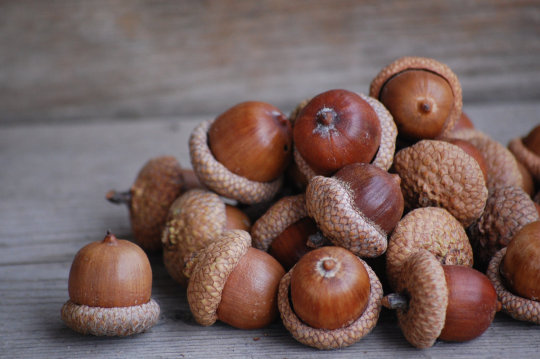
How to identify it: There are two basic types of acorn -- red acorns and white acorns; their color depends on the type of oak they come from. Acorns can generally be identified by their cups, shape, color, and size. Overall, acorns are ball-shaped or oval or some have ridges on them; and the woody cup of acorns can be hairy, scaly or smooth. Mature acorns are brown, black or red.
Where to find it: Acorns are the nuts of oak trees, and so naturally the best place to find acorns is in the drip-line of oak trees.
Edibility & flavor: Acorns taste bitter if they're not leached; however, when roasted, they have a sweetish, nutty flavor. Acorns must be boiled or soaked in water to remove the tannin, which will turn the water a brownish color. This water should be thrown out and replaced and the process repeated until the water no longer turns brown.
Benefits: Effectively controls blood sugar levels; rich in complex carbs, minerals & vitamins; lower fat content than other nuts; good source of fiber.
Caution: Acorns contain tannins, which can be toxic in large amounts and can prevent you from absorbing nutrients. Too much tannin has been linked to cancer and liver disease.
Burdock (Arctium lappa)
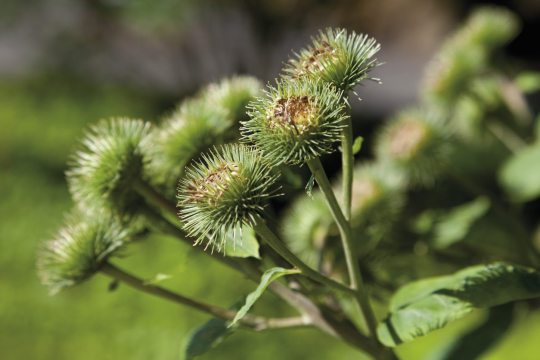
How to identify it: Has large, wavy-edged leaves that are light-colored, woolly on the underside and darker and smoother on the top side. Stalks can grow 4 to 5 feet; flowers are pink and purple with hooked bracts that can adhere to fur and clothes.
Where to find it: Found in pastures, fencelines, and disturbed areas with little competition from surrounding foliage.
Edibility & flavor: Peel the outer layer before eating; can be eaten raw or cooked. Raw burdock is earthy and kind of bittersweet like an artichoke.
Benefits: Contains tons of antioxidants, purifies the blood, may serve as an aphrodisiac, and can treat skin issues (such as acne and eczema).
Caution: Burdock can grow alongside and closely resemble belladonna nightshade, which is toxic. Burdock is also a natural diuretic, so don't ingest it if you're dehydrated.
Catnip (Nepeta cataria)

How to identify it: Catnip is a member of the mint family and, aside from a characteristic minty scent, can also be identified by its square stems and its green to gray-green foliage covered in fine hairs.
Where to find it: Catnip thrives in poor soil conditions, so look for it along railroad tracks, open meadows and fields, along fences and near old houses, near streams and in other areas you'd also expect to find weeds.
Edibility & flavor: Catnip can be eaten raw but has a strong mint flavor; the ideal way of ingesting it is as a tea.
Benefits: Contains antioxidants and other medicinal compounds such as nepetalactone (sedative), thymol (anti-inflammatory), and pinene (antioxidants, antimicrobial, neuroprotective). Catnip also contains calming qualities that promote relaxation.
Caution: Can cause headaches and vomiting in high doses.
Chanterelle Mushrooms (Cantharellus cibarius)

How to identify it: Vary in color from almost white to deep yellow to almost orange. Their caps begin flat-shaped, then become funnel-shaped. The edges curl with age and become wavy or lobed. The stems are solid and smooth and paler at the base.
Where to find it: The best places to find Chanterelles are in mixed hardwood forests, especially around oaks, maples, beeches, poplars and birches. In Southern regions, they can be found beneath blueberry bushes.
Edibility & flavor: Chanterelles can be eaten raw, but caution is advised. If possible, eating them cooked is preferable. They have a slightly fruity taste, sometimes with a hint of apricot or peach flavor, minus the sweetness.
Benefits: Rich in Vitamin D, boosts immunity, and strengthens bones.
Caution: Somewhat similar to jack-o-lantern mushrooms, which are toxic and can cause intense cramps and digestive issues.
Common Mullein (Verbascum thapsus)
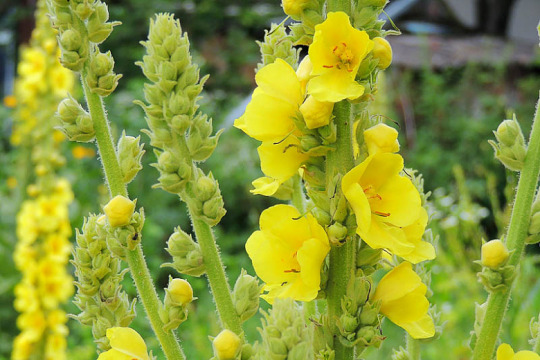
How to identify it: Mullein's defining features emerge in its second year, when it develops a tall, erect stem, growing up to 2 to 7 feet tall. It has soft leaves and yellow flowers.
Where to find it: Common mullein is found in neglected meadows and pasture lands, especially along fence roads, railroad tracks, in vacant lots, wood edges, forest openings, and industrial areas.
Edibility & flavor:
Benefits: Includes beneficial compounds such as saponins, flavonoids, phenylethanoid, iridoids, which are antioxidants, antibacterials, antivirals, and anti-inflammatories.
Caution: Skin contact with mullein can cause skin conditions, such as contact dermatitis.
Common Sheep Sorrel (Rumex acetosella)

How to identify it: Grows as a rosette of arrow-shaped leaves joined by a creeping root system. Every spring, its rosettes blossom into reddish upright flowers.
Where to find it: Located in open, disturbed areas, such as pastures, meadows, roadsides, and rights-of-way. Prefers gravelly and/or sandy soils and doesn't tolerate shade.
Edibility & flavor: The leaves and roots are edible raw or cooked. It has a slightly sour, tangy flavor due to its levels of oxalic acid.
Benefits: Historically used to treat inflammation, scurvy, diarrhea and, according to some limited research, heart issues and cancer. Contains antioxidants and nutrients like Vitamin C, fiber and magnesium.
Caution: Can cause kidney stones in large amounts, as well as damage to the kidneys, liver, and digestive organs.
Common Yarrow (Achillea millefolium)
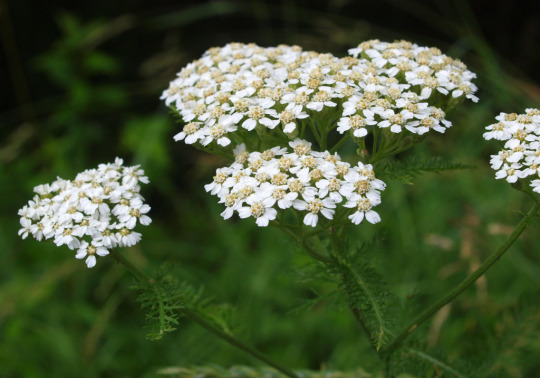
How to identify it: Wild Yarrow typically has white or, rarely, pink flowers; cultivated, it can have yellow, orange, pink or red flowers. The stems are grooved and have small, woolly hairs. Smells distinctly of pine needles.
Where to find it: Prefers sunny locations on thin, sandy soils, such as along roadsides or in fields, waste areas, canyon bottoms, subalpine zones, and even on lawns.
Edibility & flavor: Can be eaten raw or cooked, and has a somewhat bitter flavor.
Benefits: Treats digestive issues, such as ulcers and IBS, bloating, diarrhea, stomach pain, and constipation. Contains compounds that aid in digestion.
Caution: Can slow blood clotting, so avoid ingesting if you're bleeding or have a bleeding disorder. Yarrow can also cause an allergic reaction in people allergic to ragweed and other plants in the Asteraceae / Compositae family.
Dandelions (Taraxacum)

How to identify it: Both flowers in the above photo are dandelions. The white puffball upon which many people blow to scatter its seeds into the wind is what the yellow flowers mature into. These yellow flowers grow on single, unbranching, hollow stems and the leaves are lobed and produce a milky sap.
Where to find it: Dandelions can generally be found anywhere -- in lawns, gardens, parks, meadows, pastures, and disturbed areas. They prefer shade but they still thrive in hotter locations with direct sunlight.
Edibility & flavor: Both flower and stem are edible and can be eaten raw or cooked. The best time to harvest the leaves is when they're still young and tender, before they begin to flower.
Benefits: There are many health benefits of eating dandelions -- they're highly nutritious, contain potent antioxidants, are anti-inflammatories, aid in managing blood sugar, may reduce cholesterol and triglyceride levels, may lower blood pressure, may promote liver health, may aid in weight loss, may support healthy digestion and treat constipation, may boost immunity, may treat skin conditions, support health bones, and may have some cancer-fighting effects.
Caution: Dandelions can increase stomach acid and heartburn in some people, as well as cause skin irritation. People with kidney problems, gallbladder problems, and gallstones should check with their doctors before ingesting dandelions.
Field Chickweed (Stellaria media)
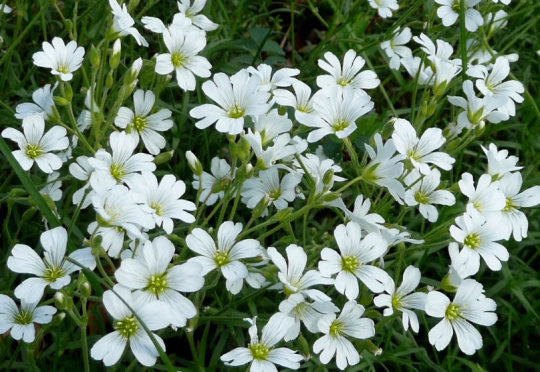
How to identify it: Chickweed is tender, stringy, and rarely grows more than a few inches off the ground. The leaves are small, grow opposite each other along the stem, and are small and teardrop- or egg-shaped with pointed tips.
Where to find it: Generally found in open, grassy areas and lawns.
Edibility & flavor: Chickweed can be eaten raw or cooked. It has a fresh, grassy flavor many compare to corn silk.
Benefits: Reduces inflammation, fights germs, promotes weight maintenance, and boosts immunity.
Caution: Though the potential for poisoning is low, large amounts of chickweed can cause diarrhea and vomiting.
#shtf plan#edible plants#edible flowers#f&d#food and drink#outdrs#foraging#gardening#prep#prepper#prepping#survival#survivalism#survivalist#off the grid#offgrid#acorns#burdock#catnip#chanterelle mushrooms#mullein#sheep sorrel#yarrow#dandelions#chickweed#part 1
98 notes
·
View notes
Text
-Flowers/plants I feel represent the V3 cast based on flower language-
A/N: Had a funky idea earlier so i decided to do it ejejeje
Hope you have a good day!!!
--------------------------------
Kaede: Chamomile [Represents resilence in adversity, Renewal and rebirth], Rose Leaves [You may hope], Dandelion [Happiness, Cheerfulness]
Shuichi: Bittersweet (Woody Nightshade) [Truth, honesty, friendship and platonic love] Red Columbine [Anxiety and great fear] and Striped Carnation [Refusal.]
Angie: Rue [Grace, Clear Vision], Snapdragon [Deception, Graciousness] and Yellow Tulip [A smile that radiates Sunshine.]
Himiko: Zinnia [Mourning of lost friendships, lasting loyalty or affection], Willow [Sadness] and Blue Salvia [I think of you.]
Tenko: Violets [...Partially because she as gay af and they are intertwined with Sapphos poetry and Lesbianism, and because of their meaning of watchfulness and faithfulness.] As well as Spearmint [Warmth of Sentiment] and Tansy [Declaration of war and hostility.]
Rantaro: Coriander [Hidden worth/merit], Spring Crocus [Cheerfulness, Youthfulness and Gladness] and Valerian [Readiness.]
Kiibo: Daisy [Innocence, loyal love, The keeping of secrets], White Roses [Purity + good intentions/youthfulness] and Oak [Strength.]
Miu: Clematis [Mental Beauty], Hollyhock [Ambition] and Red Roses [Sensuality, passion and romance.]
Korekiyo: Hydrangea [Gratitude for being understood, Frigidity and Heartlessness], Yellow Jasmine [Grace and Elegance] and Oleander [Caution.]
Ryoma: Borage [Bluntness, Directness], Butterfly Weed [Let me go] and Purple Hyacinth [Sorrow.]
Tsumugi: Yellow Hyacinth [Jealousy/Envy], Sweetpea [Blissful pleasures, Good-bye, Thank you for your lovely time.]
Kirumi: Sweet Woodruff [Humility], Thyme [Courage, Strength], Nasturium [Conquest, Victory in the face of failure.]
Kokichi: Monkhood [Beware a deadly foe is near], Yellow lily [False happiness], Cactus [Endurance] and Begonia [Beware.]
Gonta: Iris [Faith, hope, belief in the strength of friendship], Magnolia [Nobility] and Orange Blossom [Innocence]
Kaito: Blue Violet [Faithfulness, Always being there] Pine [Hope, Pity] ,Narcissus [Egotism, formality and kindness.]
Maki: White Heather [Protection, the fulfillment of wishes], Forsythia [Anticipation] and Daffodil [Unrequalled love, regard, the sun is always shining when I'm with you.]
#drv3 headcanons#kaede akamatsu headcannons#kaede akamatsu#shuichi saihara#shuichi saihara headcannons#angie yonaga#angie yonaga headcannons#tenko chabashira#tenko chabashira headcannons#himiko yumeno#himiko yumemo headcannons#korekiyo shingujji#korekiyo shingujji headcannons#rantaro amami#rantaro amami headcannons#drv3 kiibo#kiibo headcannons#miu iruma#miu iruma headcannons#ryoma hoshi#tsumugi shirogane#kirumi tojo#kokichi ouma#kaito momota#maki hurkawa#gonta gokuhara
32 notes
·
View notes
Photo

“That which walks in the Wood / Knows why it walks or why it cries...”
01. prelude - patrick wolf 02. the rolling of the stones - the young tradition 03. the abney ritual - bare bones 04. poor murdered woman - martin carthy 05. robin is dead - sharron kraus 06. brambles - the memory band 07. through the wood - arrowwood 08. chimacum rain - linda perhacs 09. kaleidoscope - tiamat 10. within hollows - autumn grieve 11. o deep woods - solanaceae 12. thistles - twelve thousand days 13. under the willow tree - mediaeval baebes 14. watcher pt. 1 - the future kings of england 15. looking for the hermit’s cave - sharron kraus 16. the wind that cracks the leaves - in gowan ring 17. sweet william - tunng 18. funeral lullaby - arrowwood 19. the woody nightshade - sharron kraus 20. the bramble briar - the transmutations 21. who killed cock robin? - jill trinka 22. where the hazel grows - alphane moon 23. the woods - cosmo sheldrake
(Spotify)
#it's been years I've been working on another folk horror mix#glad to have this together at last!!#yes that's william rufus#even without margaret murray's wild (but undeniably sexy) interpretation#I thought his death made a perfect prototype#folk horror#neofolk#ambient#folk music#playlist#fanmix#music#child ballads#les mixes de moi#an 8tracks version will become available when and if they ever stop fucking around and let me actually make playlists on there
31 notes
·
View notes
Text
@foxindarkness asked
Hey! I think you haven't done Nan Elmoth yet in your flora and fauna series, and I'd really really love to see your take on it, especially if you feel like making one of your gorgeous boards to go with it!
Flora, fauna, geography and environment of Arda
As always this is not a complete list! Please always feel free to ask for more details about any category (birds, fern, spring plants, etc)
Nan Elmoth or the Valley of Stars was a deep forest East of Doriath and on the Eastern banks of the river Celon, a tributary to Aros which was itself a tributary to Sirion.
We can only speculate about the species of trees that grew here with the primary descriptor being that they block the sun.
The climate and habitat is a deep, mixed deciduous forest with high moisture, higher than most of Doriath.
Mountain ash or Rowan, common beech and oak, and some towering pine trees are the most common species. Importantly, Yew trees grow throughout Nan Emloth and produce patches of near darkness where little else can grow.
Field and wych elms grow by the banks of Celon, needing the moist, sandy soil.
Bitter or woody nightshade grows throughout the vale as does arum, sweet violet, Great sallow, soft rush, royal ferns and bracken, common fragile fern, baneberry, black touch me not
Green shield moss, silky forklet moss, thyme moss and grey-cushioned grimmia are examples of species of mosses that grow on land in the valley.
Destroying angel mushrooms grow in the birch groves and funeral bell, panther’s cap, false death cap, bay bolete, lichens like Cladonia bellidiflora, Lobaria virens and beard lichens grow throughout on and around both decaying and healthy trees.
There was apparently a small lake or pool called Gladuial. This was likely a spring fed by ground water or a vestigial pool that remained fed by precipitation throughout the year
Common water moss clings to rocks in the river Celon, thriving in the shade the trees of Nan Emloth provide. Water starwort also grows here.
There are a number of vernal pools dotted throughout the forest Small vernal pools like these are always wonderfully diverse mini ecosystems.
Curled pondweed, amphibious bistort, bur-reed, frogbit, and least duckweed among other plants grow in these.
In the spring and summer, the chorus of frogs alights the forest at night and throughout much of the day
Pool frogs and agile frogs are the most common species though common tree frogs.
Smooth newts, palmate newts, and fire salamanders can also be found.
Crested newts can be found in small pools in less shaded areas closer to the riverbank
The forest is a quiet one and songbirds are rare and unnaturally taciturn during all but a few hours each day
Common nightjar, common nightingale, and red necked nightjar
Thrushes love the berries of yew trees which are poisonous to most others. Common blackbirds, redwings, mistle thrush.
Butterflies flit in open groves, feeding on the elm, birch and herbaceous plants of the vale. These include autumnal moth, wood white, and mourning cloak among others
Mollusks can be found in both the freshwater and terrestrial habitats of the forest. Point snails, Platyla gracilis, dusky arion slug, pond snails (Galba truncatula), and marsh slug among others.
Like in the Nan Tathren, large animals are rare in Nan Emloth. Those that do enter the valley are elusive
I like to think about prehistoric creatures roaming the lands around Doriath specifically Nan Emloth and the lands North of Neldoreth. I can make a post about that in more detail if there’s interest!
27 notes
·
View notes
Note
5, 10, 19
5. which song always puts a smile on your face?
"forever young" by symbol. it isn't a funny song, and i don't have any particularly funny memories attached to it, but it's so hype that i can't help it
10. you have to get a lyric tattoo — which lyric is it?
this is a trap to get me to be cringe!! i guess i'd go with "for I feel the gripe of the woody nightshade" from daniel pemberton's "the devil and the huntsman" it isn't cringe if you're rural and pretend it's about your love of nature
19. do you have music playing right now? if so, what?
yep! "santé" by stromae
4 notes
·
View notes
Text
Solanum Dulcamara /Bittersweet Nightshade/
[Excerpt from P.V Fournier's Dictionary of Medicinal and Poisonous Plants of France.]
-
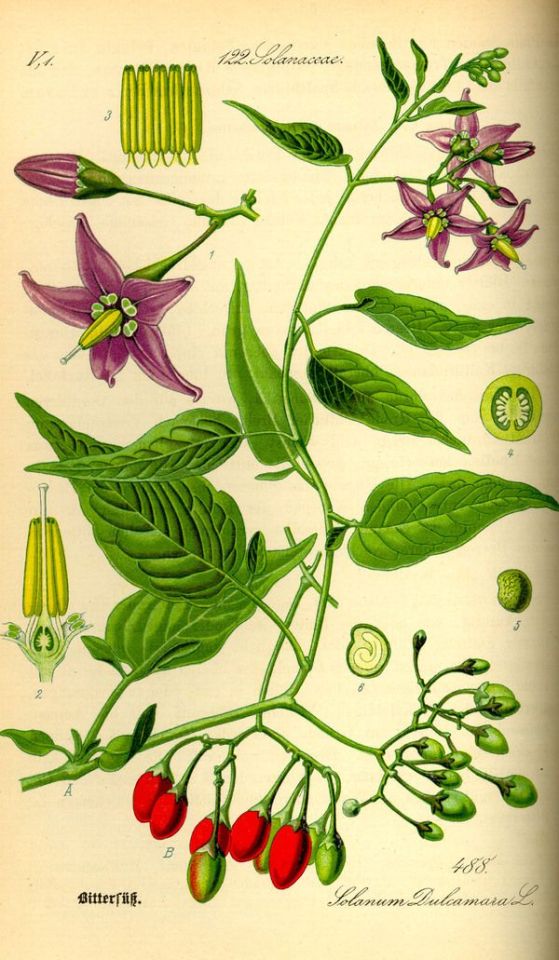
Common names : Wild licorice, climbing nightshade, Judas vine, wild vine, fever grass, foulbrood, dead dog vine.
Nothing is more graceful than the small, yellow-hearted purple star flowers of Bittersweet, that small vine native to the edges of streams and running or standing waters, light damp woods, dunes, old walls and even hollow trees, especially willows.
It is a climbing plant, more often drooping than climbing, with woody stems and herbaceous branches, which hardly reaches more than 1 to 2 meters. Its leaves are quite varied in shape on the same plant (...), [the flowers are] arranged in clusters and bloom all summer [to then] give way to small scarlet, hanging berries, which are sought by birds in winter.
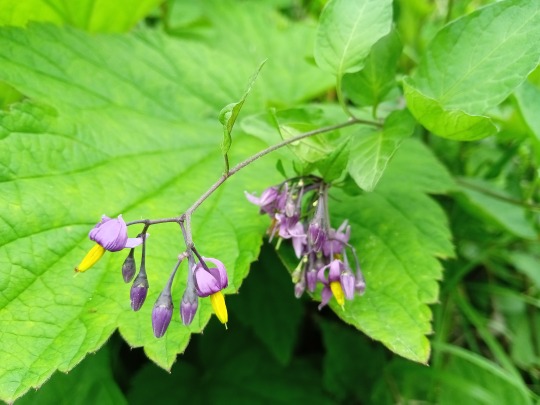
History :
The history of botany shows us that it is not certain that Bittersweet appears in ancient texts (continual confusion with Strychnos Hypnotikos and Black Nightshade), perhaps in Dioscorides however.
[You have to wait] the 16th century and the Germans to be sure that we are talking about this particular plant.
-
Dioscorides declared the plant a laxative and added that the berries dispelled all stains from the face and skin.
Mathiole asserts that the women of Tuscany also use Bittersweet as a cosmetic and that it is used in a vinous decoction against dropsy.
-
Toxicity :
It would seem that the younger the plant, the less Solanine it contains (which is also valid for Black Nightshade.)
Solanine poisoning causes nausea, vomiting, anxiety, tingling in various organs (?!?), increased secretions, agitation, cramps, convulsive movements of the hands, lips, eyelids, insomnia, vertigo, progressive paralysis of the tongue, weakening pulse, and finally, according to O. Gessner, violent dyspnoea and death by asphyxiation.
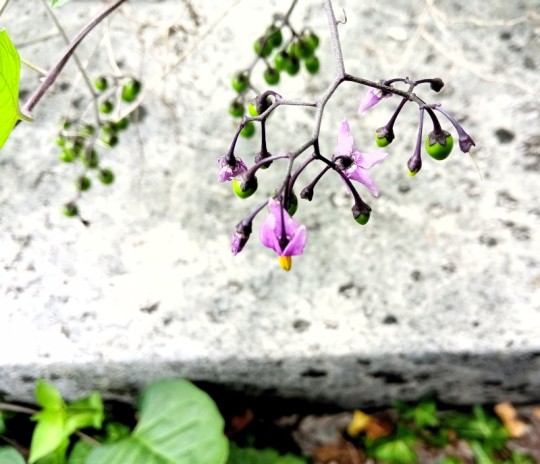
Properties :
Bittersweet is slightly laxative, diuretic, stimulant, sudorific, depurative, expectorant, antiherpetic and slightly narcotic.
The part used is the woody stem (at least one year old) chewed, who gives a feeling of bitterness followed by a sweet taste (...)
In fact, Bittersweet is mostly used as a depurative and is effective in chronic skin conditions : eczema, herpes, psoriasis, various scabs, pruritus.
-
Manual :
- Infusion or decoction : 8 to 30g per liter of water; to be taken 3 times a day between meals.
Cazin recommends starting with 4-8g per day and gradually increasing the dose, and assessing body susceptibility as you go.
It can produce at the beginning of the treatment headaches and dizziness, or even an exacerbation of the evil incriminated; but by persisting, the symptoms decrease.
However, it should be done with caution.
- Diuretic wine : 500g of stems boiled in 1 liter of white wine, 2 glasses/day.
- Decoction for lotions and baths : 100 to 200g per liter of water, young shoots or fresh leaves.
- In homeopathy its essence is used against rheumatic affections, urticaria and bladder disorders.
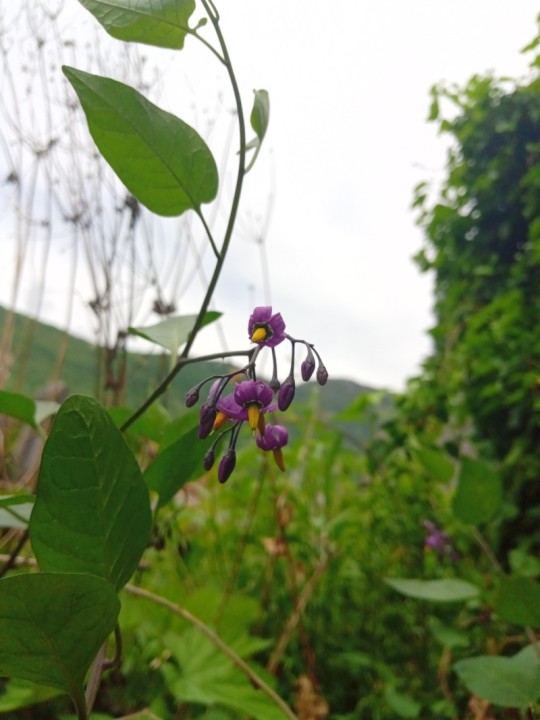
Elements of personal experience :
H. Roth as well as S. Lawless say that this plant can help to "regain its balance" or to "keep it", which seems fair to me.
Nevertheless, there is an old German legend which clearly indicates that this plant is inhabited by a very powerful Fairy (able in particular to fight step by step against *dark* witches / mares) , and I have felt few times, more than an ambivalence, an real ambiguity.
I don't have much experience with the "little people" (apart from the "ones" taken directly from the folklore of where I live), but what I have found is that indeed, the Spirit of this plant can help to find our balance, but (and) he is never there where one thinks he is, and thus he is very "good" to play certain "tricks", typical of the "little people".
With me, he was a sure 'friend' and 'ally' for a very long time, he taught me a lot of things very slowly (because I never understand anything quickly) but the FLASH he showed me once of his great power left me "mute" and "stunned" at the moment.
Also, to guard against nightmares, and unless you have a special relationship with this very powerful "Fairy", I recommend more strongly than hanging a branch of Bittersweet at the head of your bed, to place a branch of St. John's wort (among others, but it all depends on the mares in question, of course.)
30 notes
·
View notes
Photo
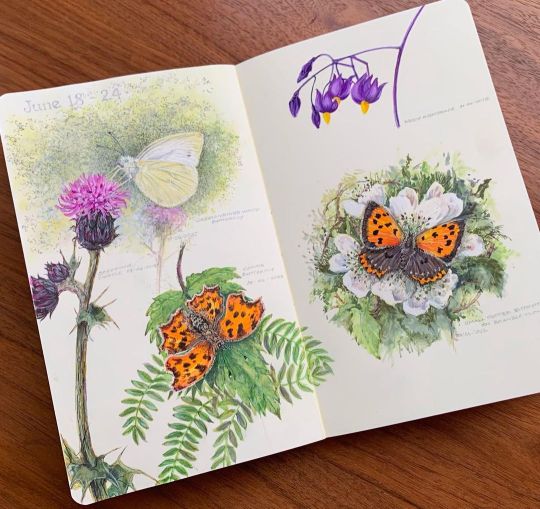
Things with wings: Green-veined White butterfly on Creeping Thistle/Comma butterfly/ Small Copper butterfly on Bramble blossom/ Woody nightshade #naturejournal #igperpetualjournal #illustration #journalpage #sketchbookjournal #watercolour #watercoloursketch #gouachepainting #greenveinedwhitebutterfly #commabutterfly #smallcopperbutterfly #creepingthistle #brambleblossom #pierisnapi #polygoniacalbum #lycaenidaephlaeas #cirsiumarvense #solanumdulcamara https://www.instagram.com/p/CfYgUibLkKk/?igshid=NGJjMDIxMWI=
#naturejournal#igperpetualjournal#illustration#journalpage#sketchbookjournal#watercolour#watercoloursketch#gouachepainting#greenveinedwhitebutterfly#commabutterfly#smallcopperbutterfly#creepingthistle#brambleblossom#pierisnapi#polygoniacalbum#lycaenidaephlaeas#cirsiumarvense#solanumdulcamara
15 notes
·
View notes